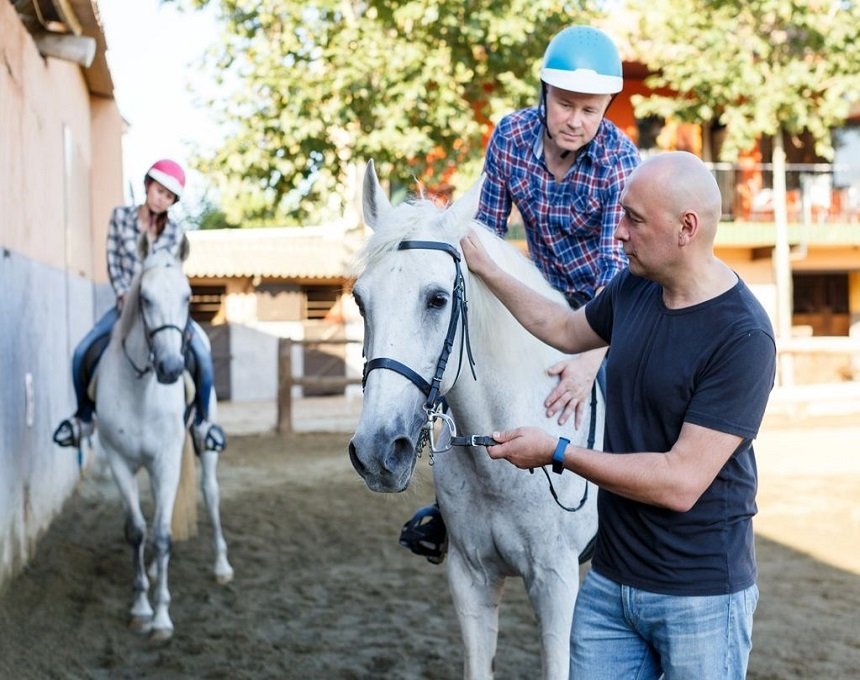Denver is a friendly, open-minded horse community. Is it your first time horse riding, or are you starting again after a long break? No problem! Everyone can find a program that suits their needs, time, and ability. This guide will provide an understanding of Horseback riding programs in Denver, how lessons work, underlying safety principles, and the smart steps to follow for enrolling with confidence.
What You Will Learn
- Major kinds of horseback riding programs in Denver
- What does the first lesson contain?
- Safety benchmarks to examine
- Pricing and what causes them to rise and fall.
- A guide to selecting a suitable school
- How to enroll and prepare to attend the first session
- What to bring and simple barn etiquette
Popular Horse Riding Program Types in Denver
Most barns and riding schools organize lessons and experiences in simple tracks:
- Private lessons (all levels): One-on-one coaching focused on balance, steering, stopping, and communication with the horse. Great for confidence-building in beginners.
- Semi-private or small group lessons: Two to four riders. Lower cost per person. Builds awareness, spacing, and control with others in the arena.
- Youth programs and camps: Fun, safe, and well-structured learning through games, groundwork, and age-appropriate hours in the saddle. Many of them teach the basics of horse care.
- Adult beginner or refresher tracks: This class provides a calming reset for those returning after a long absence. Focus on posture, cues, and safe habits.
- Trail readiness and confidence classes: Practice steering, halts, and navigating obstacles in the arena first, then apply these skills in guided trail experiences.
- Horsemanship and groundwork: Learn to lead, groom, tack up, and read body language; build trust on the ground. When the groundwork is good, riding advances more quickly.
- Equine-assisted learning and wellness experiences: Horse-guided sessions that build confidence, presence, and emotional awareness. These may not focus on riding but on personal development and connection.
Look for a path that matches your current comfort level and your long-term goals.
What Your First Lesson Usually Includes
A good first session is calm and clear:
- Welcome and safety briefing: How to move around horses, where to stand, helmet fit, and emergency stops.
- Grooming and tacking (if included): Brushes, hoof pick, and how to place saddle and bridle.
- Mounting and balance: Mount with assistance, find your seat, with heels down and eyes up.
- Basic control: Walk, halt, steer large circles, and practice safe spacing.
Expect progress at your pace. Clear communication matters more than speed.
Safety Standards to Look For
Safety is the foundation of any Denver horse riding school:
- Certified helmets: Certified by ASTM/SEI, fit properly.
- Instructor credentials and approach: Clear instruction, patient tone, and firm safety boundaries.
- Horse matching: Handle horses with a calm temperament.
- Facility upkeep: Safe fencing, tidy aisles, adequate footing in arenas, and following rules.
- Barn culture: A respectful and supportive environment where questions are welcome.
If any step feels rushed, ask the instructor to slow down. A strong program always makes space for safety.
Pricing and How Costs Usually Work
Pricing can vary by format and facility. These factors often shape the total:
- Lesson type and length: Private lessons typically cost more than small group lessons.
- Package vs. drop-in: Bundle packages can reduce the costs per lesson and help students build progressive momentum.
- Horse use and tack: Some programs involve grooming and selecting tack, while others focus on riding time in the saddle.
- Specialty Sessions: Such as trail experiences, horsemanship intensives, or equine-assisted learning, often have different prices.
- Demands and scheduling: Evenings/weekends are in demand and may be booked out earlier.
It is always best to refer to the school’s website or contact the school directly to obtain the latest information.
How to Choose the Right Fit
Use this simple checklist when comparing horseback riding programs Denver offers:
- Do I feel safe and heard during the trial visit?
- Does the program match my level and goals?
- Are helmets available and fitted appropriately?
- Is the arena footing even and well-maintained?
- Can I grow into more advanced options over time?
Consider taking an introductory lesson before committing to a large package.
Enrolling and Getting Started
- Define your goal: Confidence, fitness, trail preparedness, or advancement in skills.
- Pick a format: private for focused coaching or a small group for social learning.
- Choose a schedule: Consistency matters more than intensity. Weekly lessons compound.
- Confirm policies: Weather, attire, cancellations, and rescheduling.
- Book your first session: Arrive 10–15 minutes early to settle in and be fitted for a helmet.
Read the program descriptions carefully and pick the path that aligns with your goals and calendar.
What to Bring and Simple Barn Etiquette
- Helmet: If you have one, bring an ASTM/SEI-certified helmet; otherwise, ask if the barn provides them.
- Boots: Closed-toe with a small heel. Avoid sneakers for riding.
- Pants: Wear long, comfortable pants or breeches to avoid rubs.
- Water and sunscreen: Denver sun and elevation can sneak up on you.
- Respect personal space: Walk, do not run. Give horses plenty of space. Follow posted rules and instructor directions.
A kind word and a soft brush after your ride go a long way in building trust with your horse.
Final Thoughts
Denver offers a wealth of rich, beginner-friendly options for riders of all ages. With clear goals, steady scheduling, and a safety-first mindset, you will make real progress. Explore what horseback riding school in Denver provide, and choose an option that seems right and feasible for you. Your best ride begins with the basics done well.

Leave a Reply